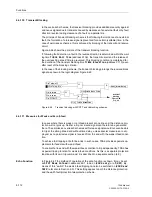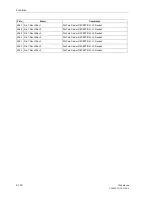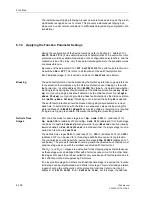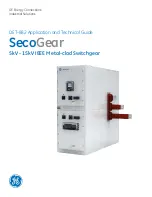
Functions
6-116
7SA6 Manual
C53000-G1176-C156-2
Figure 6-68
Distance protection setting with permissive overreach schemes
Time Settings
The send signal prolongation
Send Prolong.
(address
2103A
) must ensure that the
send signal reliably reaches the opposite line end, even if there is very fast tripping at
the sending line end and/or the signal transmission time is relatively long. In the case
of the permissive overreaching schemes
POTT
,
Directional Comparison
Pickup
and
Unblocking
this signal prolongation time is only effective if the device
has already issued a trip command. This ensures the release of the other line ends
even if the short-circuit has been cleared very rapidly by the instantaneous zone Z1.
In the case of the blocking scheme
Blocking
the send signal is always prolonged by
this time. In this case it corresponds to a transient blocking following a reverse fault.
This setting can only be modified with DIGSI
®
4 under “Additional Settings”.
With the release delay
Release Delay
(address
2108
) the release of the zone Z1B
can be delayed. This is only necessary for the blocking scheme
Blocking
, to allow
sufficient transmission time for the blocking signal during external faults. This delay
only
has an effect on the receive circuit of the teleprotection; conversely the permis-
sive signal is not delayed by the set time delay T1B of the overreaching zone Z1B. For
pilot wire comparison
and
reverse interlocking
T1B must be delayed so
that there is enough time between the pickup of the Distance Protection function and
the trip signal of zone Z1B.
Transient Blocking
The parameters
TrBlk Wait Time
and
TrBlk BlockTime
serve the transient
blocking with the permissive overreaching schemes PUTT and UNBLOCKING. With
permissive underreach transfer trip they are of no consequence. This setting can only
be modified with DIGSI
®
4 under “Additional Settings”.
The time
TrBlk Wait Time
(address
2109A
) is a waiting time before transient
blocking. Only once the distance protection recognizes a reverse fault inside this time
after fault detection, will the transient blocking become activated in the permissive
overreach transfer schemes. With the blocking scheme this waiting time prevents a
transient blocking if the blocking signal from the opposite line end is received very rap-
idly. There is no transient blocking with the setting
∞
.
The transient blocking time
TrBlk BlockTime
(address
2110A
) must be definitely
longer than the duration of severe transients resulting from the inception or clearance
of external faults. The send signal is delayed by this time with the permissive over-
reach schemes
POTT
and
Unblocking
if the protection had initially detected a re-
verse fault. With the blocking scheme
Blocking
the (blocking) receive signal is pro-
longed by this time.
The preset value is generally sufficient.
Echo Function
In the case of line ends with weak infeed, the echo function is sensible in conjunction
with permissive overreach transfer schemes POTT and UNBLOCKING with release
signal, so that the feeding line end is also released. The echo function can be enabled
A
B
Z1B(A)
Z1B(B)
PICKUP (A)
PICKUP(B)
correct
incorrect!
PICKUP(B)
PICKUP(A)
Summary of Contents for siprotec 7SA6
Page 2: ...Siemens Aktiengesellschaft Book No C53000 G1176 C156 2 ...
Page 18: ...xviii 7SA6 Manual C53000 G1176 C156 2 ...
Page 32: ...Introduction 1 14 7SA6 Manual C53000 G1176 C156 2 ...
Page 82: ...Hardware and Connections 2 50 7SA6 Manual C53000 G1176 C156 2 ...
Page 119: ...SIPROTEC 4 Devices 4 25 7SA6 Manual C53000 G1176 C156 2 Figure 4 20 CFC Logic example ...
Page 190: ...Configuration 5 62 7SA6 Manual C53000 G1176 C156 2 ...
Page 652: ...Installation and Commissioning 8 78 7SA6 Manual C53000 G1176 C156 2 ...
Page 724: ...Technical Data 10 56 7SA6 Manual C53000 G1176 C156 ...
Page 800: ...Appendix A 76 7SA6 Manual C53000 G1176 C156 2 ...
Page 866: ...Appendix B 66 7SA6 Manual C53000 G1176 C156 2 ...
















































